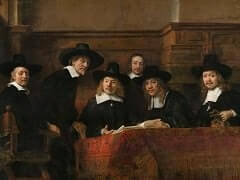Jeremiah Lamenting the Destruction of Jerusalem, 1630 by Rembrandt

Signed and dated 1630, this painting is housed in the Rijksmuseum, Amsterdam. The prophet Jeremiah laments the destruction and fire of Jerusalem, caused by King Nebuchadnezzar, who banished the Jews to exile in Babylonia. The crestfallen Prophet Jeremiah rests his weary, old head on his hand. He laments Jerusalem going up in flames - in the background - whose destruction he had prophesied. The prophet is seen surrounded by inhospitable rocks, while his beloved Jerusalem burns in the left background. The drama of the fire and the desolation are minimized - the artist is much more interested in Jeremiah himself. The prophet is richly dressed, which contrasts all the more with the gloom around him. He wears a robe of a certain sort of cool blue, which is found in a number of Rembrandt's early pictures. Jeremiah is leaning his head in his hand in an attitude of contemplative despair. The emotion is subtle, for there is a sense of infinite sadness on the old man's face, the deeply felt regret in the destruction before him. Rembrandt heightened the sense of drama with powerful contrasts of light and dark. He derived the prophet's bearded head from one of the old men he often etched around this time.
The face of the aged prophet presents features similar to Rembrandt's father Harmen van Rijn, who died shortly before this work was painted. There are no certain portraits of Harmen, however, although he appears in some works.
The painting's most unusual feature is the lavish and elaborately detailed goldwork. Rembrandt skillfully reproduces the precious metal, which glows with the reflection of what appears to be the fire ravaging the city of Jerusalem.




















